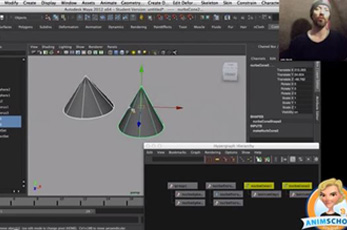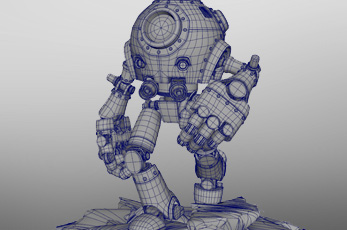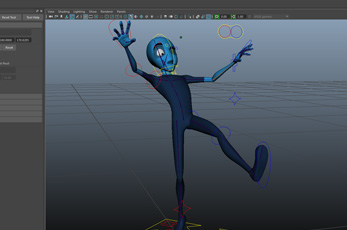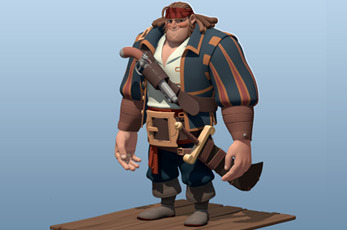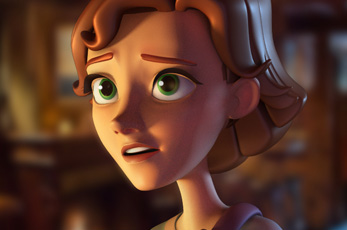3D Character Program
Make Characters
This is where the characters are made!
students learn the crafts of modeling and rigging.
What is it?
Rigging students place bones into the body to bend it properly and control the shape of the form in the myriad of possible poses.
AnimSchool is accredited by the Accrediting Commission of Career Schools and Colleges (ACCSC). ACCSC is a recognized accrediting agency by the U.S. Department of Education.
Each week, modelers and riggers (Character TDs) from film and game studios work with the students one-by-one, giving the students a guided opportunity for improving their own work.
Once a design has been sketched on paper, modeling students sculpt them in 3D. It not only has to look beautiful, but the arrangement of points and edges also have to facilitate the next step: articulation. That’s where rigging steps in.
How it works
Our 3D Character program is divided into 2 parts, the 3D Character track, and the 3D Character program.
The 3D Character track consists of classes 0-3. In the 3D Character track, students focus on modeling and rigging. In classes 4-7, our 3D Character Program, 3D Character students focus more specifically on their area of greater interest, selecting two of Five electives covering the technical, tools side of rigging, or the sculpting and facial expression side of modeling, Environments, Materials and Texturing, or Lighting.
Prior to acceptance in the 3D Character program students must successfully complete the 3D Character track classes and be accepted by the Review Board for entrance to the program or provide a reel demonstrating the prerequisite skills needed to be successful in the 3D Character Program. Each term in the 3D Character Track and Program is 11 weeks long.
Discover the 3D Character Track Courses
Learn the skills used to make 3D characters for feature films, tv productions, vr and video games.
0. Introduction to Maya
Duration: 11 Weeks
Learn the basics of Autodesk Maya. This 11-week course explores the Maya interface, working with objects, modeling basics, how to animate objects, apply materials and textures, and use lights and cameras to render your scene. Students will have the foundation they need to carry out the assignments in our programs. This course was specifically designed for students that are new to 3D, or for students that are transitioning to Maya from a different software package. Students with Maya experience can bypass this course. This course is offered at a lower tuition cost than all other courses.
1. Introduction to 3D Modeling
Duration: 11 Weeks
An introduction to the principles of polygon modeling, applied to simple objects.
This course teaches professional topology layouts for hard surface and character modeling. Students learn modeling workflows to achieve desirable shaping, and common rest states for rigging. Students model organic and inorganic objects, a real-world household object, model a designed vehicle, and a designed character bust. Students learn basic modeling concepts like edge flow, working with manipulators, isolate selection, primitives, history, loft, bevel, extrusion, duplication, transformation space, soft selection, reflection editing, lattices, converting geometry types, projects, and workspace.
Students learn how to effectively interpret a design and realize that vision in 3D space. Students will also be taught about visual appeal, and how to make their models stand out.
2. Introduction to Rigging
Duration: 11 Weeks
An introduction to the principles of rigging, applied to simple objects and scenarios.
In order for any 3D animation to happen, riggers (Character Technical Directors) take a completed character or prop model and use the concepts learned in this class to prepare it for deformation and action. Riggers insert bones (joints) into the character and refine the shapes and control systems so the character can act. Students learn basic rigging concepts including hierarchies, constraints, skinning, blendshapes, connections, joints, orientation, inverse kinematics, expressions, math nodes, xray, curve controls, custom attributes, sets, Set Driven Keys, and hypergraph connections.
Each exercise builds on the previous, so students are able ease into the complexities of rigging.
3. Intermediate Modeling ZBrush Introduction
Duration: 11 Weeks
Students learn how to use ZBrush software, learning the unique interface and workflows. Students sculpt a character from a stylized character design approved by the instructor. This course teaches professional modeling workflow and practices so students can sculpt appealing characters. Students tackle advanced body and facial modeling and learn the landmarks including: how to evaluate a model from multiple vantage points, how to simplify lines, what to look for to reveal model problems.
Students also sculpt clothing a hard surface object or set piece for their character.
NOTE: This course requires the purchase of the student version of ZBrush, typically $450.
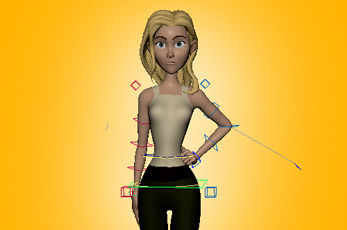
- Intermediate Rigging
Duration: 11 Weeks
This course teaches body rigging. Students build on the basic concepts and learn more complete full body rigging. Rigging controls like forward/inverse kinematics, twisting, and world/local constraints are added for ease of use during posing. Then shapes and customizations are applied to refine deformations. Student learn about multiplier attributes, lattices, wrap, nonlinear, and wire deformers, beginning Python scripting, ribbons, follicles, pose-space deformers, stretchy limbs, and gimbal avoidance.
Students learn how to make great deformations and build corrective shapes for characters. Students learn the aesthetics of body shapes.
Program Students can use their own character models from Intermediate Modeling to create a fully functional rig, and portfolio piece. Students without an approved modeled character may use one provided by AnimSchool.
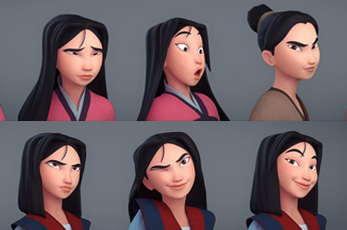
- Advanced Rigging
Duration: 11 Weeks
In this course, students learn facial rigging. AnimSchool's Malcolm 2.0 is known around the world, with over 100,000 downloads in dozens of countries. Our students learn facial rigging techniques that will help them break up facial articulation into the most usable set of functions and shapes and provide a greater range of motion. Students take their deformation work to a higher level of refinement, and develop their grasp of complex rigging issues to make performing characters. (pre-requisite: Intermediate Rigging)
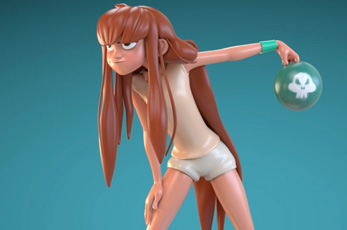
- Advanced Production Modeling
Duration: 11 Weeks
Advanced Production Modeling students learn how to create a portfolio-level character model. Students are guided through the process from selecting an approved stylized character design and using Maya's polygon modeling tools to create a character model with proper topology and edge flow that could be rigged and used in an animation production. Students learn professional techniques for modeling an entire character in a default and hero pose, searching for appeal as well as technical integrity. Through iterations and direction from the instructor, the students refine the shapes for maximum likeness to the design, appeal and usability. Concepts such as normals, UV texture projections, and smoothing are discussed. Students can use their ZBrush knowledge from the ZBrush class and work in conjunction with Maya, or model from scratch in Maya, depending on their preference.
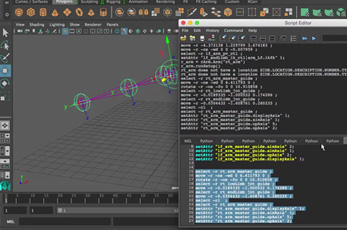
- Rigging Automation and Tools Development
Duration: 11 Weeks
Modern rigging does not rely on hand-making rig parts for each character. Auto-rigging scripts and tools make many tasks easy. They take data like input positions and number of spine joints needed and then build a control rig in a few mouse clicks. With the control rig built, optimally, Character TD’s spend most of the rigging effort per character on the deformation rig. Building those tools and modifying them for a production’s needs is a large part of the rigging process. This requires a Rigger/Character TD be proficient at scripting languages.
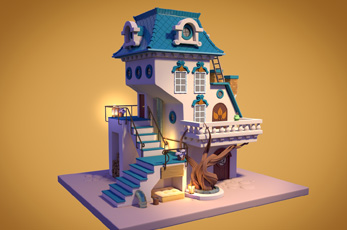
- Environment Modeling
Duration: 11 Weeks
Now it's time to place your characters into a set! Learn how to make buildings, interiors, exteriors, and set pieces. Use rhythm and style to make your sets shine. Learn the secrets of set modeling, with instruction in UV's, Cloth simming and particle distribution of elements. Learn studio pipeline needs: Asset Management, Previs, Cameras and Lights.
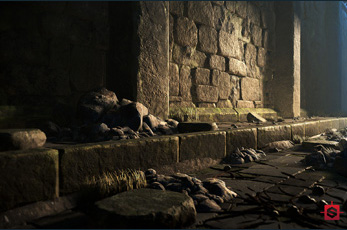
- Materials and Texturing
Duration: 11 Weeks
Students learn how to apply materials and detailed textures using Substance Painter and Maya. Once a model's shape is formed, it's the material shaders and textures that make it come alive. 3D character artists should know how to texture models to qualify for job opportunities.
- Introduction to 3D Lighting
Duration: 11 Weeks
Cinematic Lighting Principles in both real world and CG applications. Learn the basics of 3D lighting in Maya from working pros, in live classes. Learn the principles of light, shadow, color, composition, and staging. How to render professional images using Maya's tools. This course is designed for animation or modeling students, and also for students who may want to pursue lighting and rendering as a career path.
